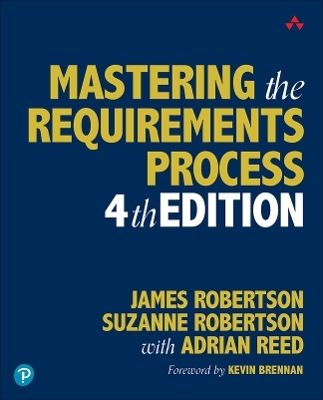
Mastering the Requirements Process
Addison Wesley (Verlag)
978-0-13-796950-0 (ISBN)
Without the right requirements it is impossible to build the right solution. Mastering the Requirements Process, Fourth Edition, gives you an industry-proven process for getting to the essence of the business problem and then writing unambiguous and testable requirements for its solution.
This fourth edition is an almost complete rewrite that brings requirements discovery into today's world--it is the book for today's business analyst. Product owners and project leaders will also find it valuable as it explains how to discover precisely what the customer needs and wants, and to do it effectively in any business or project environment.
The book tells you how to:
Use the Volere requirements process to discover requirements in both traditional and agile environments
Incorporate off-the-shelf (OTS) solutions into your requirements discovery
Use artificial intelligence (AI) as part of your requirements discovery, and as part of your business solution
Use quickly sketched prototypes to explore the problem space
Understand functional and non-functional requirements
Write better agile stories
Make your requirements and stories measurable and testable using fit criteria
Use business events as the heartbeat of business analysis
Discover requirements in agile, commercial, and milspec project environments
Find and prioritize your customer segments
Leverage systems thinking when discovering requirements
Use story maps and other requirements repository techniques
Know which trawling techniques are the most effective for requirements discovery
Synchronize your requirements discovery with agile development teams
Make better decisions in the early days of a project to increase your chances of success
Employ the Volere requirements specification template (downloaded 10,000+ times) as the basis for your own requirement specifications
"One of the most valuable things about this book is that it provides a process to follow that will get people asking the right questions and expand their perspective on the problem."
--Kevin Brennan
Register your book for convenient access to downloads, updates, and/or corrections as they become available. See inside book for details.
James Robertson and Suzanne Robertson are two of the most respected names in business analysis and requirements discovery. During the Robertsons' careers, their books, templates, training, and consulting have helped hundreds of companies to upgrade their requirements discovery process. The Robertsons have written numerous books, among others the three previous editions of this book, Business Analysis Agility, and with their co-authors at the Atlantic Systems Guild, the acclaimed Adrenaline Junkies and Template Zombies. James and Suzanne live in London and France.
Foreword xxiii
Preface xxv
Acknowledgments xxvii
About the Authors xxix
Part I: Requirements Are the Root of Everything 1
Chapter 1: Requirements Fundamentals 3
Requirements Fundamental 1 3
Requirements Fundamental 2 3
Requirements Fundamental 3 4
Requirements Fundamental 4 5
Requirements Fundamental 5 5
Requirements Fundamental 6 6
Requirements Fundamental 7 6
Requirements Fundamental 8 7
Requirements Fundamental 9 7
Chapter 2: Your Requirements Arena 9
A Requirements Process 9
Review 16
Part II: Project Blastoff 19
Chapter 3: Understand the Real Problem 23
The Problem 24
The Real Business Problem 25
The Goal Statement 28
Review 30
Resources 31
Chapter 4: The Value of Solving the Problem 33
What Does Your Customer Value? 33
Receiving Value 37
Review 39
Resources 39
Chapter 5: Goals-Scope-Stakeholders 41
Goals 42
Scope 45
A Presumed Solution 52
The Context Diagram 53
Stakeholders 57
Review 63
Resources 64
Chapter 6: Customer Segments 65
Customers and Their Segments 65
Personas 68
Prioritizing the Customer Segments 71
Review 73
Resources 73
Chapter 7: Business Events 75
Understanding the Work 76
What Are Business Events? 77
Why Business Events Are a Good Idea 82
Finding the Business Events 82
Ready-made Solutions 84
Review 86
Resources 86
Chapter 8: Prioritizing the Business Events 87
Priority, Priority, Priority 87
Estimating Effort 89
Prioritization Factors 91
Approval Voting 93
Business Analysis Planning 93
Review 94
Resources 95
Chapter 9: To Go or Not to Go? 97
The Likelihood of a Successful Project 98
Ready-made Solutions 101
Develop the Business Case 101
To Go or Not to Go 106
An Agile Approach to Blastoff 107
Review 109
Resources 109
Part III: Prototyping for Requirements 111
Chapter 10: Generating Sacrificial Candidate Solutions 115
Multiple Candidates 115
Review 118
Resources 118
Chapter 11: Prototypes, Prototypes, Prototypes 119
Types of Prototypes 119
Review 130
Resources 130
Chapter 12: Ready-Made Solutions 131
Prototyping with Ready-Made Solutions 131
Choosing Ready-Made Solutions 136
Review 139
Resources 140
Chapter 13: Creative Candidate Solutions 141
Creative Triggers 141
Lateral Thinking 148
Removing Constraints 148
Combination 150
Review 150
Resources 150
Chapter 14: Probing and Exploring the Candidates 153
Probing 153
Exploring 157
Double-Loop Learning 161
Review 164
Resources 165
Chapter 15: Using Prototypes as the Specification 167
The Prototype as the Specification 168
What to Do with the Prototype 169
Evolutionary and Sacrificial Prototypes 171
Review 172
Part IV: Trawling for Requirements 173
Chapter 16: The Essence of the Problem 177
The Problem 177
Abstraction 178
Essence 178
Ask Why—Again, and Again, and Again 180
Referred Pain 182
Disguised Problems 183
Review 184
Resources 185
Chapter 17: Business Events and Business Use Cases 187
Business Events 187
The Business Use Case 190
Trawling the BUCs 191
The Desired Future BUC 192
Prototyping and BUCs 193
Describing the BUCs 193
Review 194
Resources 194
Chapter 18: The Brown Cow Model 195
How Now, Brown Cow? 195
How to Use the Brown Cow Model 198
Review 200
Resources 200
Chapter 19: Workshops 201
BUC Workshops 201
Mechanics of a Successful Workshop 203
Review 206
Resources 206
Chapter 20: Scenarios 207
What Is a Scenario? 207
The Essence of the Business 212
Alternatives 215
Exceptions 216
Misuse Cases and Negative Scenarios 218
Review 218
Resources 219
Chapter 21: Stories 221
The Business Event Story 221
Review 230
Resources 230
Chapter 22: Business Process Models 231
Notation 232
Activity Diagrams 233
Data Flow Diagrams 234
Business Events and BUCs 236
When to Use Process Models 238
Review 240
Resources 241
Chapter 23: Stored Data 243
Data Models 243
CRUD Check 250
Review 252
Resources 252
Chapter 24: Other Trawling Techniques 253
Apprenticing 254
Interviewing 255
Business Rules 258
Rich Pictures 260
Creativity Workshops 261
Document Archeology 262
Customer Experience Analysis 264
Review 266
Resources 267
Part V: Writing Good Requirements and Stories 269
Chapter 25: Functional Requirements 271
Uncovering the Functional Requirements 272
Deciding the Solution's Functionality 273
Writing the Requirements 275
The Snow Card 278
Technological Requirements 281
Level of Granularity 281
Conditional Requirements 282
Avoiding Ambiguity 282
Grouping Requirements in Your Specification 284
Requirements for Ready-Made Products 284
Review 285
Resources 285
Chapter 26: Non-functional Requirements 287
PUCs and NFRs 289
Non-functional Requirement Types 290
Look and Feel Requirements: Type 10 291
Usability and Humanity Requirements: Type 11 293
Performance Requirements: Type 12 297
Operational and Environmental Requirements: Type 13 299
Maintainability and Support Requirements: Type 14 300
Security Requirements: Type 15 302
Cultural Requirements: Type 16 306
Compliance Requirements: Type 17 308
Finding the Non-functional Requirements 309
Don't Write a Solution 313
Review 314
Resources 315
Chapter 27: Fit Criteria and Rationale 317
Why Does Fit Need a Criterion? 318
The Rationale for the Rationale 320
Finding Fit Criteria 322
Scale of Measurement 323
Fit Criteria for Non-functional Requirements 324
Fit Criteria for Stories 333
Fit Criteria for Functional Requirements 333
Fit Criterion for Project Purpose 336
Fit Criteria for Solution Constraints 336
Review 337
Resources 338
Chapter 28: Writing Good Stories 339
Business Event Stories 339
Properties of Good Stories 341
INVEST 345
Non-functional Properties 346
Review 347
Resources 348
Chapter 29: Acceptance Criteria 349
Given/When/Then 349
Who Writes the ACs, and When? 352
Review 352
Resources 353
Part VI: Designing Business Solutions 355
Chapter 30: Business Solutions 359
Business Outcomes 360
Review 363
Resources 364
Chapter 31: Determine the Extent of the Automation 365
What Should You Automate? 365
Iterative and Evolutionary Design 367
Prototypes Can Help 368
Architecture 370
Review 371
Resources 372
Chapter 32: Designing Information and Functionality 373
User Experience = Information + Functionality 374
Review 376
Resources 377
Chapter 33: Designing Using Ready-Mades 379
The Request for Proposal 379
Selecting the Best Ready-Made 383
Review 390
Resources 390
Part VII: Requirements Repository 391
Chapter 34: Requirements Specification 395
Structure of the Specification 396
Resources 398
Chapter 35: Story Map 399
The Story Map 399
Growing the Map 403
Enhancing the Map 405
Adding Non-functional Requirements to the Map 406
Prioritizing the Map 408
Using the Map Iteratively 410
Review 411
Resources 412
Chapter 36: Quality Thinking 413
Within Scope? 413
Relevancy 415
Completeness of a Requirement 417
Testing the Fit Criteria 419
Consistent Terminology 420
Viability 421
Requirement or Solution? 422
Value of the Requirement 423
Gold Plating 423
Scope Creep and Your Project 424
Review 426
Resources 427
Chapter 37: Completeness Check 429
Have All Business Events Been Discovered? 430
Define the Business Data 431
CRUD Check 434
Review 436
Resources 436
Chapter 38: Managing Requirements 437
Traceability 437
Tracking Status of Requirements 441
Change Management 443
Review 446
Resources 446
Part VIII: The Conduct of Business Analysis 449
Chapter 39: Your Process 451
Serial or Agile? 451
A Common Language 452
Making It Your Process 453
Review 457
Resources 458
Chapter 40: The Importance of the Early Days 459
Why Do Things Go Wrong? 459
Resources 462
Chapter 41: People 463
Drivers of Human Behavior 463
Review 466
Resources 466
Chapter 42: Systems Thinking 467
Thinking About Systems 467
Ripple Effects 469
External Influences 470
The Wider View 471
Using Data to Find Missing Connections 472
Review 472
Resources 473
Chapter 43: Artificial Intelligence (AI) 475
Using AI for Requirements Discovery 475
AI in Business Processes 478
Review 480
Resources 480
Chapter 44: Learning as You Go 481
Lessons Learned 481
Review 483
Resources 484
Chapter 45: Requirements and Innovation 485
The Value of Innovative Requirements 486
An Innovation Process and Requirements 486
A Culture for Innovation 488
The Sanctity of the Incomplete Idea 490
Innovation and Requirements 491
Resources 492
Appendix A: The Volere Requirements Specification Template 495
Volere 499
Requirement Types 499
Testing Requirements 499
The Snow Card 500
1. The Purpose of the Project 500
2. The Stakeholders 503
3. Constraints 508
4. Naming Conventions and Terminology 515
5. Relevant Facts, Business Rules, and Assumptions 516
6. The Scope of the Work 519
7. Business Data Model and Data Dictionary 524
8. The Scope of the Product 528
9. Functional Requirements 532
Non-functional Requirements 535
10. Look and Feel Requirements 535
11. Usability and Humanity Requirements 536
12. Performance Requirements 542
13. Operational and Environmental Requirements 547
14. Maintainability and Support Requirements 551
15. Security Requirements 553
16. Cultural Requirements 556
17. Compliance Requirements 558
Project Issues 560
18. Open Issues 560
19. Ready-Made Solutions 561
20. New Problems 563
21. Tasks 565
22. Migration to the New Product 566
23. Risks 568
24. Costs 569
25. User Documentation and Training 570
26. Waiting Room 572
27. Ideas for Solutions 572
Appendix B: Stakeholder Management Templates 575
Stakeholder Map 575
Stakeholder Template 577
Appendix C: Volere Requirements Knowledge Model 579
Using the Model 579
Interpreting the Model 579
Example Requirements Knowledge Model 580
Dictionary for Requirements Knowledge Model 581
Knowledge Model Annotated with Template Section Numbers 594
Glossary 595
Bibliography 601
Index 607
| Erscheinungsdatum | 05.09.2024 |
|---|---|
| Verlagsort | Boston |
| Sprache | englisch |
| Maße | 188 x 232 mm |
| Gewicht | 1200 g |
| Themenwelt | Mathematik / Informatik ► Informatik |
| ISBN-10 | 0-13-796950-3 / 0137969503 |
| ISBN-13 | 978-0-13-796950-0 / 9780137969500 |
| Zustand | Neuware |
| Informationen gemäß Produktsicherheitsverordnung (GPSR) | |
| Haben Sie eine Frage zum Produkt? |
aus dem Bereich


